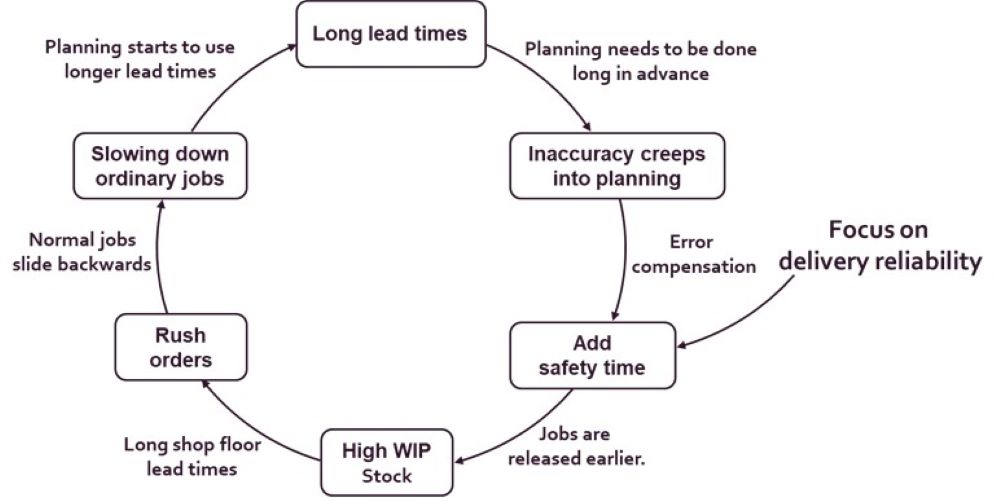Taking control over the lead time spiral
Delivery reliability is an important factor for many customers. The key to improving delivery reliability lies in increasing capacity in a timely manner.
The pitfall of building in safety times
Planners who feel pressure to increase delivery reliability will often add 'safety time' to their planning. However, this is the start of a harmful spiral.
Increasing the lead time parameters in the system by adding a safety time will result in orders being released earlier, which will increase intermediate stocks waiting around on the shop floor, leading, in turn, to longer lead times. With longer lead times, there will be more rush orders, which will have to take precedence over regular orders. This further delays normal orders, so extending their lead times. These longer lead times then force Planning to plan further into the future. As a result, further inaccuracies creep into the planning, which again compromises reliability of delivery. This, in turn, leads to a tendency to increase safety times even further. The vicious circle is now complete.
And the moral of this story is: you cannot improve delivery reliability by focusing directly on delivery reliability. You cannot control the lead time spiral by manipulating planning parameters. The solution lies in breaking the spiral by reducing lead times. A shorter lead time reverses the spiral, which can drastically improve delivery reliability.
Capacity as leverage
International research shows that carefully adjusting the available capacity is an important tool for controlling lead times and improving delivery reliability.
In a simulation study of a typical job-shop environment, three strategies for improving delivery reliability were compared:
- Using other rules to determine order sequence at the workstations. Four rules were compared: First Come, First Served (FCFS), earliest production end date first, shortest production time first, and a combined rule that mixes the 'earliest production end date first' rule with the 'shortest production time first' rule.
- Timely and slightly increasing capacity at busy times.
- Systematically increasing capacity by 0.5 percent. (This half percent was the average increase with the second strategy).
The utilisation level of the job shop in the simulation was 90 percent in the base case. The results of the simulation are given in the table below, which shows 'Percentage of late orders' and 'Average number of days late'.
| Sequence rule for the orders | Utilisation level of the job shop | Percentage of late orders | Average number of days late | |
| First Come, First Serve | 90% | 23,7% | 3,67 | |
| 89,5% - firm capacity | 21,2% | 3,07 | ||
| 89,5 % - flexible capacity | 16,9 % | 1,72 | ||
| Earliest production end date first | 90% | 12,1 % | 1,03 | |
| 89,5% - firm capacity | 9,8% | 0,78 | ||
| 89,5 % - flexible capacity | 2,8% | 0,06 | ||
| Shortest production time first | 90% | 5,8% | 2,46 | |
| 89,5% - firm capacity | 5,5% | 2,19 | ||
| 89,5 % - flexible capacity | 5,3% | 1,72 | ||
| Combined rule | 90% | 5,0% | 0,49 | |
| 89,5% - firm capacity | 4,1% | 0,38 | ||
| 89,5 % - flexible capacity | 1,3% | 0,04 |
A number of clear conclusions can be drawn from the table:
1. The order rules affect the delivery time:
- 'First Come, First Served' clearly performs the worst. This is logical since this rule only takes into account the time of the order and not the requested delivery date.
- Sorting orders according to the shortest production time in production greatly reduces the percentage of late orders, but also ensures that large orders are heavily delayed. As a result, the average number of days late is greater than with the 'earliest production end date' rule.
- The combined rule performs best as it combines a low percentage of late orders with a low 'average number of days late'.
2. Even a very small increase in capacity has a clear effect on delivery reliability. Half a percent more capacity quickly leads to about 10-20 percent fewer late orders.
3. The greatest gain in delivery reliability comes from increasing capacity at busy times. This led to a relative decrease in late orders by about 75 percent when using good order sequencing rules (such as 'earliest production end date first').
Increasing capacity was always triggered by monitoring the workload. As soon as the workload at a station exceeded a set limit, the capacity was increased. In their study, the researchers also looked at the effects of different trigger points, the size of the capacity increase and the duration of the capacity increase. The study shows that the details of the capacity increase do not have much effect. For example, a large capacity increase over a short period seems to have about the same effect as a smaller capacity increase over a longer period.
Management conclusions
Four clear management conclusions can be drawn from the study:
- Carefully monitor the workload of each workstation.
- Provide flexible capacity that you can use during periods of higher load. A short-term increase in capacity by 20 percent seems to work well.
- Respond quickly to increasing workloads and increase capacity as soon as the workload exceeds set limits.
- There is a clear trade-off between delivery reliability and capacity. If you want higher delivery reliability, you must be prepared to temporarily deploy more resources at peak times if you are going to keep lead times under control.
Would you like to know more?
In the Spring of 2024, we will organise a new series of lessons on quick-response manufacturing. This QRM Silver training will give you a deeper insight into QRM. The series of lessons includes testimonials from business leaders, various case studies and QRM simulation games. A 10-part evening course will start on 19 March 2024 in Ghent and a 4-part day course will start on 16 May 2024 in Genk.





